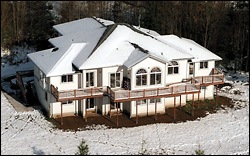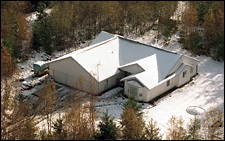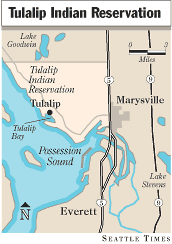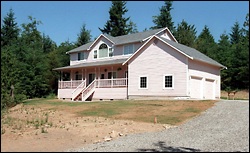 |
 |
 |
| Your account | Today's news index | Weather | Traffic | Movies | Restaurants | Today's events | ||||||||
|
December 1, 1996
Despite their $92,000 income, Tulalip couple got housing aid
At nearly 5,300 square feet, it's three times the size of the average American home. The front features a two-story decorative column bordered on one side by cedar decking and on the other by tall, arched windows and a two-car garage. In the back, a raised deck wraps around the gabled structure from end to end, with rows of view windows lining the first and second floors.
The house can't be seen from the road. And there are some who
wish it wouldn't be seen at all — namely, those responsible for
building it and the couple living there, who earn more than $90,000
a year.
The money came from a U.S. Department of Housing and Urban Development program to build low-cost homes for low-income tribal members. Yet neither this house nor the income of its owners violates the program's newly relaxed rules — deregulation meant to give tribes more freedom in spending a half-billion dollars a year in aid for housing.
That freedom has come with a toll: Deregulation has opened the
door to flagrant, widespread abuses at the expense of Native
Americans living in some of the worst housing conditions in this
country. Some 100,000 Indian families live in squalid, overcrowded
dwellings, often with no plumbing or electricity.
From the rocky beaches of Puget Sound to the baked clay of New Mexico's mesas, from the dusty streets of the rural Otoe reservation in Red Rock, Okla., to the bright lights of the sprawling Foxwoods casino in Connecticut, opportunists have taken advantage of regulatory loopholes to create an anything-goes atmosphere. Many of those opportunists are Native Americans who play politics and favoritism within their own tribes. Others are non-Indians — including some former HUD employees — who see the Indian-housing program as an easy mark. The big house in the woods There is probably no better symbol of the abuses than the big house in the woods on the Tulalip Indian Reservation, about 40 minutes north of Seattle.
The house is owned by Patti Gobin, executive director of the
Tulalip Tribes Housing Authority, and her husband, Michael Alva, the
agency's contracting officer. Their income of $92,319 is five times
the $18,300 average income of participants in this home-ownership
program.
This enormous house was one of 18 built for Tulalip-reservation residents under the HUD program. Most of them are large enough to blend into any upscale suburban subdivision. Although none of the others is as big as the Gobin-Alva house, several are over 2,000 square feet and as big as 3,000 square feet, and three have three-car garages. They were built with $2.5 million in tax dollars earmarked for low-income housing at the Tulalip reservation. Among those who got these HUD houses were Gobin's daughter, one of her best friends and another member of the housing-authority staff. Some of these homeowners could pay as little as $175 a month for their houses for 15 to 25 years, at which point they would get the deeds. They also have the option to buy the houses outright with private financing for up to $60,000 less than they cost to build. The difference comes from taxpayers' pockets. Designed to help low-income The Tulalip subdivision was built under a HUD program called "Mutual Help," started in 1962 as a way to give low-income Indian families a chance to own decent, affordable houses. Here's how it's designed to work: HUD gives Indian-housing authorities money to build houses. Low-income tribal members pay monthly installments — usually 15 percent of their household income - to the authority for a set period. The authority then uses that cash flow to keep its housing program afloat. Without Mutual Help, many Native-American families would never have a chance to own a decent house. Banks generally won't give home loans to reservation Indians. Most don't have the income to qualify. And even if they do, reservation land is trust land with special sovereignty status, and a bank could not foreclose on it should a loan go bad. In the past, banks would loan money only for mobile homes and trailers, called "wheelies" by Indians because banks could wheel them away if the borrowers defaulted. For most of three decades, Mutual Help seemed to be achieving its goals. More than 50,000 houses were built under the program, with an average size of 1,200 square feet. "No program made such a difference on my reservation other than maybe the health clinic," said Coni Wilson, who runs the Quinault Indian Housing Authority in the tiny village of Taholah on the Olympic Peninsula. Still, 250 Quinault members sit on a HUD waiting list, living in conditions most Americans would consider intolerable. Wilson, who is also vice chairwoman of the Northwest Indian Housing Association, tracks carefully what other Northwest tribes do with their money from HUD. That's become especially important to her since 1992, when HUD began loosening oversight to give tribes more control of the Indian-housing program: Wilson knows that if she doesn't follow the money, it's likely no one will. So when her colleague Patti Gobin started talking about building her dream house on the Tulalip reservation, Wilson wondered immediately where the money would come from. Gobin belongs to an influential family in one of Washington state's most thriving Indian communities. Blessed by strong leadership and a good location just off the I-5 corridor, the Tulalip confederation of small tribes controls 22,000 acres of lush forest and meandering shoreline west of Marysville. When Gobin first showed Wilson her house plans, Wilson blinked at the size. Afterward, the realization sank in: Gobin must be planning to build the house with Mutual Help money. Wilson alerted two HUD officials: Dominic Nessi, deputy assistant secretary for the Office of Native American Programs (ONAP), which administers Mutual Help, and Jerry Leslie, ONAP's Northwest regional director. Nessi, who oversees the program nationally from Washington, D.C., said he told Leslie, based in Seattle, to check it out. But Leslie says he doesn't remember talking to Nessi or Wilson about it. He said the Tulalip Tribes Housing Authority told his staff it was going to take advantage of the program's new flexibility to build some showcase low-income homes instead of traditional HUD boxes. The housing authority provided sample house designs but none looked exceptionally large, Leslie said. HUD approved the $2.5 million grant and forked over money, but did little else. Under deregulation, HUD staff no longer had to make site visits, sign off on plans or otherwise keep a close watch on the money. By the time HUD officials awoke to what Gobin and Alva were doing, the paint had dried and word had spread throughout the state's Indian community that the Tulalip agency had built an amazing house and it was OK with HUD. 'Doing what so many dream of' Gobin refuses to talk about her house, referring all questions to Alva, her husband. Alva insisted that officials from HUD's Indian-housing office in Seattle knew all about the Tulalip agency's plans to build big houses. In fact, Alva said, HUD officials held the Tulalip program up as a model. Alva produced a September 1995 letter from John Barber, the senior adviser in the Seattle regional office, thanking Alva for giving a group of visitors a tour of the construction site. "I hope many others, especially from the Indian Community, have a chance to see first-hand that you are doing what so many dream of," Barber wrote. HUD architect Don Klein made an informal stop at the reservation shortly after Barber's visit. He wanted to check out the rumors of big houses for himself, and sure enough he found some. But what really gave him pause was the size of the foundation for the Gobin house. "It was clearly for a very large structure," he said. He alerted his bosses. But again, in the spirit of deregulation, they saw no reason to follow up. When HUD's Northwest office finally dispatched three staff members to the development in February, there was little they could do besides stand in the mud outside the Gobin house and wonder how they were going to explain it to the public. Under HUD's new, more relaxed rules, they were hard-pressed to identify any clear-cut violations. There are no limits on size or amenities for low-income housing. There are limits on cost, based on size and location, but they apply to the average cost per house in a development. The tribe could build as expensive a house as it wanted, so long as the cost was offset by some cheaper houses. A staff member reported seeing water jets in some of the bathtubs in the subdivision, inspiring a two-day discussion among top HUD officials on whether Jacuzzis were suitable for federally financed low-income houses. They eventually decided the whirlpool baths were improper but could not find any regulation banning them. The discussion reflected just how far afield the Indian-housing program had gone under the new rules. "Under the old system, this would never have happened," Leslie said. "We would have checked the plans. We would have been monitoring it on a regular basis. That had its negatives, too. It got to the point that people didn't blink without HUD approval. "There has to be something in between." HUD's 'new flexibility' HUD used to regulate Mutual Help developments closely, making calls on details from design to cost. Beginning in 1992, under HUD Secretary Jack Kemp, and continuing in 1993 under Secretary Henry Cisneros, the agency began shedding regulations. HUD officials proclaimed a new era in which the agency would be more partner than regulator of Indian-housing authorities. It was dubbed the "new flexibility." "It follows a general approach throughout government that relates to empowerment of local communities," said Nessi, a principal architect of the new era. "That's a major issue with tribal governments, because of their status as independent nations." In theory, it meant local Indian officials could make more of their own decisions about how best to meet the needs of their low-income populations. In practice, though, it has resulted in a shocking lack of oversight about how half a billion dollars a year in federal aid are being spent. HUD's new, relaxed rules do the following: • Dispense with the requirement that housing authorities base the sales price of homes on actual cost. Now, housing authorities can set any price they want. Although many tribes price them prudently, others have used this provision essentially to give houses away to tribal leaders. • Call for moderate houses but do not define "moderate." Some housing authorities are using the money to build bigger and fewer homes at a time when the need for houses is at an all-time high. • Allow five homes per project to go to upper-income families, even if poorer ones are waiting. • Allow Mutual Help homeowners to spend their own money for luxury upgrades of their houses, prompting many critics to ask why homebuyers with money to spare should get federal subsidies. Such expensive extras as Jacuzzis, decks, skylights and three-car garages are often added to already well-endowed homes. Even with the changes, nobody in HUD's administration expected to see the program pay for a 5,300-square-foot house. Said Nessi, the deputy assistant secretary: "We do not want to have a home like that built in this program." Records show HUD officials tried to resolve the situation quickly, quietly, and with minimal scrutiny by their own staff and outsiders. Leslie, the Northwest director, at first insisted Gobin and Alva pay for the house or risk losing future funding for tribal housing — a threat he now admits he probably couldn't have carried out. Finally, Gobin and Alva agreed to pay a price based on a cost estimate from the housing authority's contract officer — who just happened to be Alva. HUD agreed. Leslie asked for no backup documentation, even after acknowledging Alva's conflicting interests as homebuyer and price-setter. When his staff complained that the breakdown did not include site work, planning or administrative costs, Leslie discussed it with Alva but agreed not to make an issue of it. Alva set the price at $214,000, and HUD accepted it. Leslie arranged a special deal for a government-insured private loan through HUD's Federal Housing Administration. The house was too big to qualify for FHA insurance as a single-family residence, so an accommodating FHA official classified it as a duplex. Internal audit ordered As part of the deal, Leslie called off inspection of the other large houses — some of the biggest Mutual Help houses in the country - and left it up to Tulalip officials to decide whether they were "modest." That might have ended the matter last April if The Seattle Times had not started asking questions. Within weeks, the HUD inspector general began an audit, over objections from Leslie and his boss, Nessi. With news of the audit, Leslie withdrew his authorization of the $214,000 sales price and warned the couple that the figure might go higher. But Alva and Gobin could not qualify for a higher loan, leaving the fate of the house in limbo. Leslie suggested the tribe make the house a shelter for homeless teenagers, an idea that got a cool reception from the tribe and a heated one from Alva and Gobin. Leslie offered a compromise. Alva and Gobin could pay the $214,000 upfront with the help of the FHA loan. Once a new cost appraisal was provided by the inspector general, the tribe would pay the difference. But tribal officials didn't want fellow tribe members to know their money would be used for the big house. (Most still have no idea.) So, Leslie agreed to let Gobin and Alva cover the difference with housing-authority money, if the Tulalip tribes would donate an equal amount of money to a special fund for housing programs. Leslie's staff wrote a memo warning against the agreement: The tribe could back out of the deal, and the inspector general's findings might be serious enough to force Alva and Gobin out of their jobs, resulting in a default that would return the problem house to HUD. But Leslie decided to proceed. And he didn't make his accommodations in a vacuum: Nessi and other top officials weighed in all along the way. In fact, at the start, Ted Key, the second in command at HUD's Office of Native American Programs, reprimanded Leslie's staff for visiting the development site at all without clearance from tribal officials. When Leslie wrote a position paper for tribes to clarify the proper use of Mutual Help money in light of the Tulalip controversy, he drew another reprimand from Key for being too authoritative: "I have a hard time understanding why your staff has taken two years to understand the change in our relationship with Tribal Governments," Key wrote. "We don't 'allow' Tribes, anymore than they 'allow' HUD . . . WE ARE PARTNERS!" Dream deal for dream house Alva and Gobin moved into their dream house in August. If they had had it built, like any other middle-income couple, they would have paid upward of $400,000, not including the land, according to real-estate and construction experts. Instead, they had their home built at substantial savings by a nonprofit housing agency's in-house construction team, which is paid with money from HUD. The inspector general is expected to set the actual cost of the house at $260,000, Leslie said. The deal with Leslie ensures they won't pay more than $214,000 — 18 percent under cost and half the market rate. Taxpayers also remain on the hook for the federally insured FHA mortgage Alva and Gobin obtained to help pay for the house. If they default, the government has to pay off the mortgage. In retrospect, Alva said, he and Gobin should not have built their house through the housing authority, because of their positions. "It's appearances," he said. But Craig Dougall, who does consulting work with Northwest tribes, recalled a conversation with Alva more than a year ago about how easy it would be to get away with building a big house, because HUD officials no longer check designs or visit construction sites until after the fact. "I said, 'What are they going to do? Burn the house down?' " Dougall recalled. But even Dougall was surprised by Alva's action. "It was a theoretical discussion. I didn't expect him to do it."
Copyright © 1996 Seattle Times Company, All Rights Reserved.
|
|
|||||||||||||||||||||||||||||||||||||||||||||||||||
seattletimes.com home
Home delivery
| Contact us
| Search archive
| Site map
| Low-graphic
NWclassifieds
| NWsource
| Advertising info
| The Seattle Times Company



